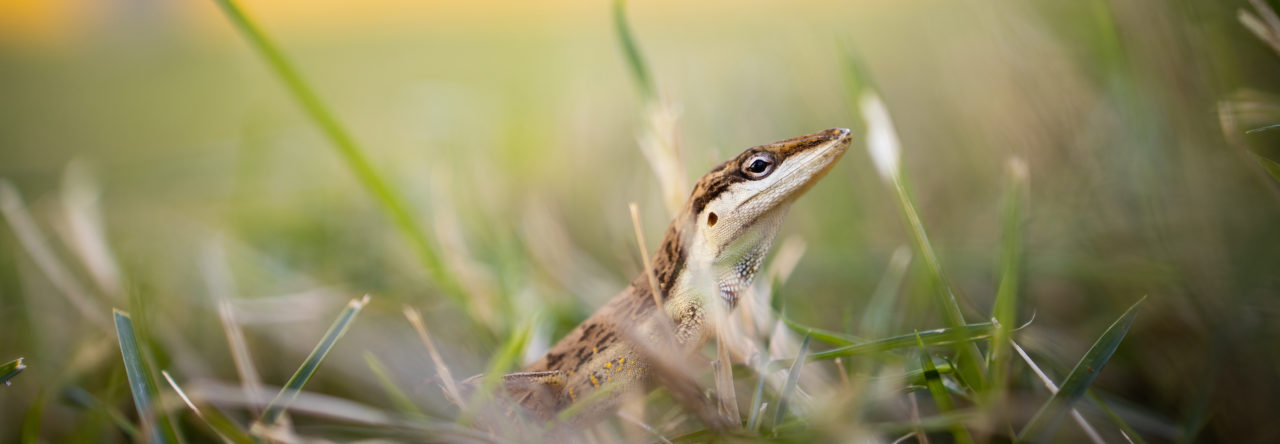
Anoles are well known for the sharp differences in dewlap colour and size between females and males. However, this is not true for all the species of the genus. Anolis heterodermus is a large arboreal lizard that inhabits shrubs and small trees in the cloudy Andean forests in Colombia and northern Ecuador. Although males are slightly bigger than females, this species has no apparent sexual dimorphism in dewlap size or colouration. Anolis heterodermus is a slow-moving lizard that relies mainly on its body colour pattern to camouflage from predators, thus its common name Andean “chameleon.” Moreover, these lizards have a long prehensile tail which is very useful when moving through thin branches. Interestingly, males curl and swing their tail to their opponents during aggressive encounters.
The body colour pattern is incredibly variable in this species, but all animals have a small patch of bluish scales in the base of the tail. After keeping some of these lizards in captivity, I noticed that the colouration and size of this patch changed dramatically between animals, and even within the same animal over the course of the day. Every time I arrived at the lab in the morning, the patch was small and reddish (Fig. 1A) but after midday, it seemed bigger and with an intense blue colouration (Fig. 1B).

Figure 1: Colour and size variation in the tail patch of Anolis heterodermus. The same male has A) a reddish patch at 06:40 h and B) a bluish patch at 14:47 h.
I thought that the colour and/or size of this tail patch were somehow related to a male’s quality and that could be the reason why males display their tail in the combats. If my hypothesis was correct, males (but not females) would have a larger variation in patch colour and size that is dependant on the time of the day. With the help of some colleagues, I collected males and females of A. heterodermus across the Eastern Cordillera of Colombia. I housed the lizards separately and took photographs (Fig. 1) from each animal every hour between 6:30 to 18:00 h. On each photo, I measured the colour and size of the tail patch. Colour was scored as the ratio of blue vs. red intensities (Blue:Red score), where a larger score indicates bluer scales.
I found that the tail patch of Anolis heterodermus changed from red to blue throughout the day and was generally bluer in males. However, contrary to my hypothesis, the colour change was similar between females and males (Fig. 2). In addition, the coloured patch remained the same size throughout the day in both males and females but was bigger in males.

Figure 2. Diurnal colour change in the tail patch of males and females of Anolis heterodermus. Larger values of the Blue:Red score indicate bluer scales.
Active colour change in lizards often occurs in the context of intraspecific communication (e.g. territorial and courtship behaviour). However, my animals were kept isolated from each other; thus is unlikely that the change in colouration per se is conveying social information. Intriguingly, the highest values of blue colouration for both males and females were reached around midday, which corresponds to the natural peak of activity of the species and possibly to higher body temperatures. In this case, the colour change might be an indicator of animal activity or arousal. This could also explain why the blue colouration disappears at night (personal observation).
Finally, the fact that the patch was significantly bigger and bluer in males compared to females supports the hypothesis that the patch can be relevant in male interactions. It would be interesting to test if the colouration and size of the patch are related to male performance or overall quality.
These are just some of the many questions that still need to be answered about the colour change in the Andean “chameleon,” and this study highlights the importance of observations in the laboratory to identify traits that might be important but difficult to observe in nature.
Original article: (2019) Diurnal colour change in a sexually dimorphic trait in the Andean lizard Anolis heterodermus (Squamata: Dactyloidae), Journal of Natural History, 53:1-2, 45-55. DOI: 10.1080/00222933.2019.1572245
- Color Change In the Andean “Chameleon” - March 24, 2019


Leave a Reply